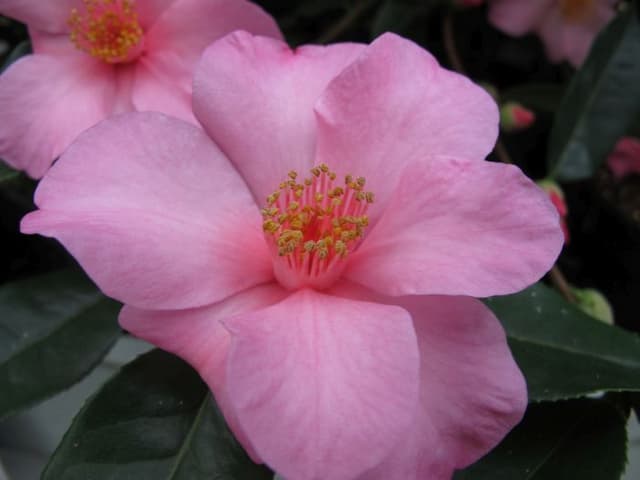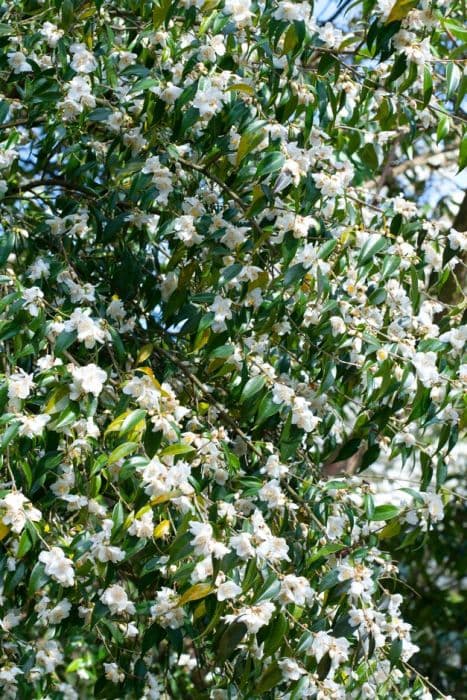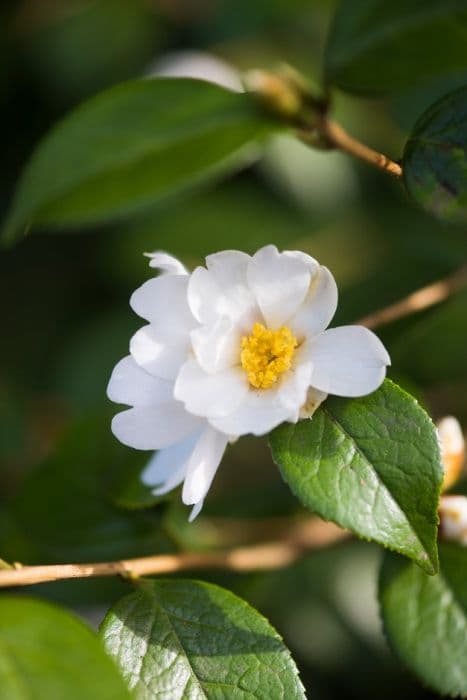Tea plant Camellia sinensis
ABOUT
The tea plant, commonly known as the tea plant, is a flowering evergreen shrub with glossy green leaves and a bushy habit. The leaves are robust and have serrated edges, appearing alternately arranged on the stems. These leaves are typically a vibrant green color, and when crushed, they release a distinctive, aromatic fragrance, which is characteristic of the tea that is made from them. The tea plant also produces small, white flowers with a yellow center, which are quite fragrant. They have a delicate appearance, with a few petals that are usually arranged in a single row. After the flowering period, the tea plant may produce small, green to brownish fruit that contains seeds, but it is primarily cultivated for its leaves. The appearance of the stems can vary, but they often have a light brown to gray bark that may appear slightly rough to the touch. Overall, the tea plant has a graceful and attractive look, making it desirable not only for its leaves that yield tea but also as an ornamental shrub in gardens.
About this plant
 Names
NamesFamily
Theaceae.
Synonyms
Tea Plant, Tea Shrub, Chinese Tea, Assam Tea.
Common names
Thea sinensis, Camellia thea, Camellia bohea, Camellia chinensis, Camellia oleosa, Camellia theifera, Thea bohea, Thea chinensis, Thea viridis.
 Toxicity
ToxicityTo humans
The most common common name for Camellia sinensis is tea plant. It is not generally considered toxic to humans. In fact, leaves from the tea plant are widely used to produce tea, which is one of the most consumed beverages worldwide. However, consuming large amounts of tea leaves can lead to caffeine-related side effects since the leaves contain caffeine. These effects may include restlessness, palpitations, insomnia, tremors, headaches, and gastrointestinal disturbances. Overconsumption of caffeine over a long period may also pose health risks such as increased anxiety, heart problems, or nutrient absorption issues.
To pets
The tea plant, known commonly as the tea plant, can be toxic to pets if ingested, mostly due to the caffeine content and other alkaloids present in the leaves. Symptoms of caffeine poisoning in pets may include restlessness, rapid breathing, heart palpitations, muscle tremors, and seizures. In severe cases, ingestion of tea leaves could potentially lead to collapse or death. It is important to keep any form of tea, including tea bags and loose tea leaves, out of reach of pets to prevent accidental ingestion.
 Characteristics
CharacteristicsLife cycle
Perennials
Foliage type
Evergreen
Color of leaves
Green
Flower color
White
Height
5 feet [1.52 meters]
Spread
4 feet [1.22 meters]
Plant type
Shrub
Hardiness zones
7
Native area
Asia
Benefits
 General Benefits
General Benefits- Source of Tea: Camellia sinensis is the plant from which all traditional teas, including white, green, oolong, and black teas, are harvested.
- Cultural Significance: The practice of tea cultivation and consumption is deeply rooted in various cultures, with traditions ranging from East Asian tea ceremonies to British tea time.
- Economic Importance: Tea is a major commodity in global markets, providing income and employment for millions of people worldwide in its cultivation, processing, and distribution.
- Culinary Uses: Beyond brewing, tea leaves are used in various culinary applications, from flavoring dishes to creating tea-based desserts and beverages.
- Antioxidant Content: While not a direct medical benefit, the high levels of antioxidants found in tea are associated with various health benefits, though these properties should be discussed with medical professionals for individual advice.
- Stimulant Effect: The caffeine content in tea provides a gentle stimulant effect, helping to increase alertness and concentration throughout the day.
- Hydration: Tea, especially when taken without sweeteners, can contribute to daily hydration needs when included as part of a balanced diet.
 Medical Properties
Medical Properties- Antioxidant effects: Camellia sinensis leaves are rich in polyphenols like catechins which have antioxidant properties that can help in reducing oxidative stress in the body.
- Cardiovascular health: Regular consumption of tea made from Camellia sinensis has been associated with a lower risk of developing cardiovascular diseases due to the lowering of cholesterol and improvement in blood flow.
- Cognitive function: The caffeine and L-theanine found in Camellia sinensis can help in improving brain function, enhancing alertness, and increasing focus.
- Cancer prevention: Some studies suggest that the polyphenols in Camellia sinensis may contribute to reducing the risk of certain types of cancer due to their antioxidant and anti-inflammatory properties.
- Weight management: Green tea extracts from Camellia sinensis may aid in weight loss and weight management efforts by increasing metabolism and fat oxidation.
- Blood sugar control: There is some evidence that Camellia sinensis can help in the regulation of blood sugar levels, potentially benefiting people with diabetes or at risk of developing diabetes.
- Dental health: Compounds found in Camellia sinensis, such as fluoride and catechins, may help in maintaining oral health by inhibiting bacterial growth and reducing plaque formation.
- Gastrointestinal health: The tannins in Camellia sinensis can have a positive effect on gastrointestinal health, potentially helping with digestion and reducing inflammation.
 Air-purifying Qualities
Air-purifying QualitiesThis plant is not specifically known for air purifying qualities.
 Other Uses
Other Uses- As a natural dye: The leaves of Camellia sinensis, or tea plant, can be used to create a natural dye for fabric, yielding a range of colors from light yellow to deep brown depending on the processing.
- In cosmetics: Extracts from tea leaves are incorporated into beauty products as they contain antioxidants that may help in maintaining skin health.
- Gardening: Tea leaves can be added to compost or directly used as mulch, providing nutrients to the soil and helping retain moisture.
- Decorative purposes: With its attractive flowers and foliage, Camellia sinensis can be grown as an ornamental plant in gardens.
- Cooking: Tea leaves can be used in cooking to impart a unique flavor to dishes, such as smoking meats or creating tea-infused sauces.
- Odor neutralizer: Dried tea leaves can absorb odors and are sometimes used in refrigerators, shoes, or drawers to maintain freshness.
- Tanning leather: The tannins in tea leaves can be used in the leather tanning process to produce tea-tanned leather.
- Art supplies: Tea can be used as a wash or pigment in watercolor paintings for its range of natural tones and staining properties.
- Fish farming: Tea leaves have been explored as a potential feed for aquaculture, given their nutritional content.
- Religious ceremonies: In some cultures, tea leaves are used ceremonially or offered in rituals as a symbolic gesture of respect or purification.
Interesting Facts
 Feng Shui
Feng ShuiThe tea plant is not used in Feng Shui practice.
 Zodiac Sign Compitability
Zodiac Sign CompitabilityThe tea plant is not used in astrology practice.
 Plant Symbolism
Plant Symbolism- Longevity and Vitality - Camellia sinensis, also known as the tea plant, is associated with long life and good health, possibly because the tea made from its leaves is rich in antioxidants and has many health benefits.
- Endurance and Strength - The tea plant is a hardy perennial that can thrive for many years, which makes it a symbol of resilience and the ability to endure difficult conditions.
- Purity and Calm - Tea is often consumed in rituals and ceremonies around the world, symbolizing purity of mind and the calming effect it has on the body and soul.
- Healing - With its medicinal properties, the tea plant is seen as a symbol of healing both physical ailments and soothing the mind.
- Fortune and Prosperity - In some cultures, the tea plant represents good fortune and prosperity, stemming from its economic importance and the valuable trade of tea leaves.
 Water
WaterThe tea plant, also known as Camellia sinensis, needs to be watered deeply and regularly to keep the soil consistently moist but not soggy. Water the tea plant with about 1 inch of water once a week during the growing season, and reduce watering in the winter to every two to three weeks depending on the humidity and temperature. It's best to water early in the morning or late in the afternoon to reduce evaporation. Avoid overwatering, as this can lead to root rot. It's crucial to ensure that the plant has good drainage.
 Light
LightCamellia sinensis, commonly known as the tea plant, thrives in bright, indirect light or partial shade. The ideal spot for the tea plant is one where it is protected from the harsh afternoon sun. Morning sunlight with dappled or filtered light throughout the rest of the day provides optimal lighting conditions for healthy growth.
 Temperature
TemperatureCamellia sinensis prefers a temperate climate with temperatures ranging between 60°F and 85°F. The tea plant can tolerate minimum temperatures of around 30°F, but the ideal range for thriving plants is above 50°F. Prolonged exposure to temperatures below this threshold, or to extreme high temperatures, can be detrimental to the plant.
 Pruning
PruningPruning the tea plant, Camellia sinensis, is essential for maintaining its shape and promoting healthy growth. It's best to prune in the late winter or early spring before the growing season starts. Remove any dead or damaged branches, as well as any inward-growing branches to improve air circulation. Pruning may also stimulate new growth and improve the yield of tea leaves.
 Cleaning
CleaningAs needed
 Soil
SoilThe best soil mix for Camellia sinensis, commonly known as the tea plant, should be rich, well-draining, and acidic with a pH between 4.5 and 6.5. A combination of 30% pine bark, 30% peat moss, and 40% perlite is ideal to ensure adequate drainage and maintain acidity. Regularly test the soil pH to keep it within the optimal range for tea plant health.
 Repotting
RepottingCamellia sinensis, or tea plant, should be repotted every 2 to 3 years to replenish nutrients and prevent root bounding. The best time to repot is in the late winter or early spring before new growth begins. Always use a fresh acidic soil mix when repotting to maintain optimal conditions.
 Humidity & Misting
Humidity & MistingCamellia sinensis, widely known as the tea plant, thrives in high humidity conditions, ideally between 60-80%. To achieve the best growth, the plant should be placed in an environment where there is consistent humidity within this range without fluctuations that could stress the plant.
 Suitable locations
Suitable locationsIndoor
Provide bright light and keep soil moist.
Outdoor
Plant in bright shade, shelter from cold winds.
Hardiness zone
7-9 USDA
 Life cycle
Life cycleThe tea plant, Camellia sinensis, begins its life cycle as a seed, which germinates in well-drained soil under warm, humid conditions to produce a seedling. As the seedling grows, it develops into a shrub through a vegetative stage, where it produces leaves that are characteristically glossy and evergreen. After 2-5 years, the tea plant reaches maturity and enters the reproductive stage, flowering with small white blossoms that eventually give way to seed-containing fruits if pollinated. In managed agricultural environments, tea plants are often kept pruned to a manageable height to facilitate harvesting of the young leaves and buds, which is the commercial product. These leaves go through a series of processes such as withering, rolling, and drying to produce various types of tea. Tea plants can live for over a hundred years, although they are usually replaced in commercial production after about 30-50 years when their yield decreases.
 Propogation
PropogationPropogation time
Spring-Early Summer
Propogation: Tea plants, commonly known as Camellia sinensis, can be propagated through various methods, but the most popular method is the use of cuttings. The ideal time for taking cuttings to propagate tea plants is during the late winter to early spring when the plant is dormant. Cuttings should be made from semi-hardwood segments of the parent plant, typically measuring 4 to 6 inches (10 to 15 centimeters) in length. These cuttings are then dipped in rooting hormone to encourage root development and planted in a well-draining soil mixture. The environment must be kept humid, often by covering the cuttings with a plastic bag or placing them in a propagation chamber, and the temperature should remain consistent, around 68 to 77 degrees Fahrenheit (20 to 25 degrees Celsius). Maintaining these conditions helps facilitate root growth, and with proper care, cuttings can develop into individual plants that are genetically identical to the parent.









